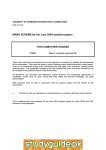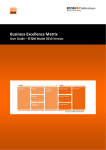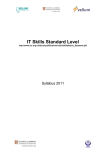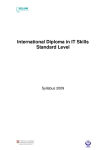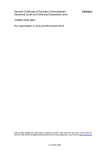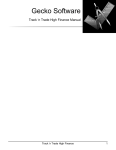Download www.xtremepapers.net
Transcript
www.studyguide.pk CAMBRIDGE INTERNATIONAL DIPLOMA IT SKILLS (FOUNDATION LEVEL) 2007 IMPORTANT NOTICES The Cambridge International Diploma in IT Skills was formerly known as the Cambridge Skills Award in Information Technology. Documents available from CIE may still refer to the old title in some places. The content of the syllabuses has not changed. University of Cambridge International Examinations (CIE) in the UK and USA University of Cambridge International Examinations accepts entries in the UK and USA only from students registered on courses at CIE registered Centres. UK and USA private candidates are not eligible to enter CIE examinations unless they are repatriating from outside the UK/USA and are part way through a course leading to a CIE examination. In that case a letter of support from the Principal of the school which they had attended is required. Other UK and USA private candidates should not embark on courses leading to a CIE examination. This regulation applies only to entry by private candidates in the UK and USA. Entry by private candidates through Centres in other countries is not affected. Further details are available from Customer Services at University of Cambridge International Examinations. You can find syllabuses and information about CIE teacher training events on the CIE Website (www.cie.org.uk). www.xtremepapers.net www.studyguide.pk www.xtremepapers.net www.studyguide.pk Cambridge International Diploma in IT Skills (Foundation Level) 2007 CONTENTS Page Section 1: Introduction 1 Section 2: Overview of the Diploma 3 Section 3: Syllabus Structure and Content 7 Application Module 1: Using the Computer and Managing Files 9 Section 4: Application Module 2: Word Processing 10 Application Module 3: Spreadsheets 11 Application Module 4: Databases 12 Application Module 5: Electronic Communication 13 Application Module 6: Presentations 14 Administration Procedures 15 www.xtremepapers.net © UCLES 2006 www.studyguide.pk www.xtremepapers.net www.studyguide.pk Cambridge International Diploma in IT Skills (Foundation Level) 2007 SECTION 1: INTRODUCTION 1.0 Cambridge International Diploma in Information Technology Information Technology (IT) influences the lives of everyone, wherever we live or work in the world. Almost every aspect of our daily lives now involves using IT skills. In the increasingly dynamic world of work, people need to be able to work effectively with IT, to develop transferable IT skills and to apply those skills across different contexts and software packages. With advances in technology, people are also keen to ensure that their IT skills are kept up to date to make themselves competent, capable and competitive in today’s employment markets. The Cambridge International Diplomas in IT recognise achievement in a range of skills which are required to use effectively a number of IT applications. These skills are assessed on the computer in the context of practical tasks. Assessments for the Cambridge International Diploma in IT are available on demand throughout the year to complement flexible training patterns and learning needs. The assessments use the latest developments in computer-based technology to assess a candidate’s ability to use software-specific applications and to develop IT skills. All assessment is carried out on-screen and the immediate feedback of results to candidates is a central feature of these diplomas. The Foundation Level Diploma provides a framework at an introductory level for developing practical IT skills and knowledge in a range of IT applications and functions. This Diploma has been developed specifically for the international market, recognising the growing importance of employees working across geographic and cultural borders. There are no formal candidate entry requirements for the Foundation Level Diploma. It is, however, expected that Centres will have the appropriate range of equipment and software needed to train and assess candidates. 1 www.xtremepapers.net © UCLES 2006 www.studyguide.pk Cambridge International Diploma in IT Skills (Foundation Level) 2007 1.1 The International Dimension Cambridge International Diplomas in IT embody performance standards valued in countries around the world. The use of IT is a transferable skill and can be demonstrated regardless of place, system or culture. The syllabus and assessments provide a framework through which candidates, wherever they might be, can be assessed reliably and validly against the performance standards set in a software-specific context. However, candidates should be aware that, with the use of an appropriate manual and sufficient practice, the IT skills acquired can be used across a variety of manufacturers’ software. The syllabus and assessments are available in English and Spanish. The assessments do not, however, directly assess language skills, but are designed to give candidates the opportunity to show they can apply the skills specified in the syllabus. 2 www.xtremepapers.net © UCLES 2006 www.studyguide.pk Cambridge International Diploma in IT Skills (Foundation Level) 2007 SECTION 2: OVERVIEW OF THE DIPLOMA 2.0 Aim The aim of the Foundation Level Diploma is to assess a candidate’s ability to use Information Technology effectively when using specific software applications. Within each application area, candidates will be required to enter and manipulate data, work closely to given specifications and successfully complete a range of tasks as specified. During the assessments, they will be required to edit, copy, save and/or print the data on which they are working as appropriate. 2.1 Target Group The Foundation Level Diploma is designed for anyone who wishes to develop basic competence in specific IT applications and to gain a broad introduction to practical, work-related IT skills. It is suitable for students, employees and trainees who wish to develop practical IT skills and for those who wish to receive recognition for basic IT competence that they may already possess. Basic competence in keyboarding skills, the use of a mouse and the ability to load an application are assumed. A knowledge of general principles and procedures in the use of IT hardware and software is encouraged to be taught alongside the practical IT skills. Further guidance on these principles and procedures is given in Section 3.1. 2.2 Diploma structure The Application Modules available in the Cambridge International Diploma in IT at Foundation Level are as shown below: Application Module Status Form of Assessment Using the Computer and Core Module 45 minute practical task Word Processing Core Module 45 minute practical task Spreadsheets Core Module 45 minute practical task Electronic Communication Core Module 45 minute practical task Databases Optional Module 45 minute practical task Presentations Optional Module 45 minute practical task Managing Files Each skill area can be tested separately as and when a candidate is ready and when the centre is able to schedule and accommodate the assessment process. All candidates will receive immediate feedback of results indicating how well they have performed and whether or not they have passed the module assessment. Successful candidates can receive a Statement of Results that is issued locally by the Registered Centre (see Section 2.8 below). 3 www.xtremepapers.net © UCLES 2006 www.studyguide.pk Cambridge International Diploma in IT Skills (Foundation Level) 2007 To achieve the Cambridge International Diploma in IT at Foundation Level, candidates must successfully complete all Core Modules and at least one from a choice of Optional Modules. When the five Application Modules have been completed successfully, a candidate will receive a full Cambridge IT International Diploma certificate. 2.3 Learning Hours and Course Structures There is no fixed guide to the learning hours required for the individual modules or for the full Diploma. It is, however, expected that about 10 hours per module, or about 50 hours for the full diploma, will be sufficient for most students who start with little or no background knowledge of, or competence in, IT skills. This figure is a guideline only as different students will often progress at different rates and will generally start the course with a range of prior knowledge and experience. Centres should plan the duration and delivery of courses based on an understanding of candidates’ prior qualifications and experience. CIE considers that there are various effective methods of developing IT skills, including tutorials spread over a period of weeks or months, intensive training programmes, on-the-job training or other supervised work experience, and distance learning. There is, therefore, no single prescribed course structure leading to the Cambridge International Diploma in IT. Centres and students may wish to start with the ‘Using the Computer and Managing Files’ module although there is no set route through the modules. It is possible for students to start with any module. For example, a student who is particularly interested in one of the applications covered may choose to begin with this Application Module. Success in this module may well encourage interest in and take up of the other modules in the Diploma. Centres may identify demand for courses linked to particular modules or need to provide for particular groups or organisations that need to develop or update specific skills. These are just two examples of the flexibility of provision that the diploma structure supports. Generally, whatever the method of skills development, students are first taught the skills required by particular processes (e.g. Word Processing) through the medium of appropriate application packages. Centres should note, however, that the IT assessment software is application software-specific. Attention should be given to familiarise candidates who have developed IT skills using other software packages with those used in the assessment. Centres are free to decide when to assess in terms of their own and the candidates’ readiness. 2.4 Learning Support Materials CIE provides a range of support materials that will aid both tutors in preparing for the delivery of their courses and candidates in their learning. These materials contain exercises to be completed on the PC using data files provided as well as information to be read, learned and understood. The aim in providing these materials is not simply to provide a pre-packaged course but to help provide a suitable learning environment for candidates. Details of these materials, which consist of Candidate and Tutor Support Guides, are available from CIE Customer Services. 4 www.xtremepapers.net © UCLES 2006 www.studyguide.pk Cambridge International Diploma in IT Skills (Foundation Level) 2007 2.5 Resources Students will require frequent access to appropriate IT facilities to develop their skills. Centres will therefore need to have sufficient, appropriate facilities available to allow students access as necessary. The scale of this provision will clearly depend on the number of candidates likely to enter for the assessments over a given period and the nature of the course and its method of delivery. The Cambridge IT International Diplomas are software specific and only suitable for use on PCs that operate using Windows 95, Windows 98 or Windows NT version 4.0 or later, Windows 2000 or Windows XP. The minimum specification for the PC running the Administrator software is: Pentium P166, 32Mb RAM (64 Mb RAM highly recommended), 256 Colours, 640x480 resolution, 50 Mb Hard Disk space available, multimedia enabled (i.e. including a CD-ROM drive), and with a Printer Driver installed. At this specification, the screen will not show all of the graphics properly and a display set to 800x600 with 65576 colours is highly recommended. The minimum specification for a PC running the Testing software is: Pentium P166, 16 Mb RAM (64 Mb RAM highly recommended), 256 colours, 640x480 resolution, mouse, keyboard and VGA colour monitor. The same recommendations as above apply with regard to the display. The PC user will also need to be able to have access to Microsoft Office Professional 97, Office 2000 Professional or Office XP Professional products. PCs also need to fulfil the minimum specification required to run the respective MS Office Professional applications. Assessment for four of the five Application Modules is built on Microsoft products. For these four modules, students will be assessed using the particular software packages. Students should, however, be encouraged to realise that, with the aid of a manual, they can learn the necessary skills and easily transfer their skills to a variety of products and other packages, should they need to do so. 2.6 Method of Assessment At the end of a period of study, or when they are ready, candidates take a CIE-set assessment. These assessments are computer-based and are available on demand. Centres enter candidates for the assessments using the software supplied by CIE on a CD-ROM. The Centre Administrator (using the software supplied) generates the test exercises following the guidelines issued by CIE. Candidates then take the assessment on a computer, using the on-screen exercise instructions to navigate through the actual assessment. Candidate Instructions for taking the IT assessments are available on the CD-ROM. These are printed and distributed by the Centre to candidates prior to the test. Each Application Module in the Diploma is assessed separately and distinctly, with assessments comprising a number of tasks being taken under controlled conditions at the Registered Centre. For the four Application Modules of Word Processing, Databases, Spreadsheets and Presentations, the assessment is divided into three ‘separate’ exercises. Each exercise has a set of on-screen instructions which the Centre Administrator can print out and distribute to candidates who wish to follow instructions on paper, prior to the test commencing. The Application Module in Using the Computer and Managing Files comprises a single exercise with several sets of instructions involving manipulation of a number of files across a number of directories and associated file management activities. 5 www.xtremepapers.net © UCLES 2006 www.studyguide.pk Cambridge International Diploma in IT Skills (Foundation Level) 2007 The Electronic Communication module is assessed by two 'separate' practical tasks, one in a simulated email application, the other in a simulated internet environment. The simulation enables those organisations where networking facilities are not yet available to gain accreditation for the necessary practical skills and to encourage development of the skills required. The assessments for all of these modules focus on the candidate’s ability to carry out practical tasks rather than to explain the theory of how the tasks are completed. Candidates are assessed on their performance of these tasks. Each Application Module assessment is designed to be completed in 45 minutes or less. Candidates are shown the time remaining for the assessment by an on-screen clock. At the end of 45 minutes the test will automatically end and begin to mark the tasks carried out by the candidate. 2.7 Availability Assessments for the Cambridge International Diploma in IT are available at any time throughout the year. Centres must be registered with, and approved by, CIE before the Administration and Assessment software is issued. A Registered Centre is then issued with a CD-ROM containing the software that is licensed to the Centre for use as intended. This software allows Centres to offer assessments as required to fit in with the delivery of training. Assessments may be taken at the end of the course of study or they may be taken at intervals over the length of the course as an aid to learning. Centres can decide when the assessment takes place, as there is no fixed timetable. The Administrator software system that allows assessments to be selected for candidates and a number of reports on an individual’s performance can be generated. Centres purchase in advance, and are assigned, blocks of tests covering all the Application Modules, on obtaining the security codes from CIE (see Section 4). 2.8 Quality Control and Assurance - Protecting Cambridge International Diploma Standards CIE has to ensure the integrity of its assessment procedures, so that everyone can have full confidence in the standards issued by CIE. In applying for Registered Centre status, Centre staff acknowledge that they will follow the requirements of the diploma, to the standards described in the syllabus and guidelines. CIE will assess the suitability of staff, premises, resources, and procedures, before allowing Centres to operate the IT Diplomas, or other, Diplomas. As this may involve a visit by CIE personnel to a Centre, Centres are advised to apply for the status of ‘Registered Centre’ well before the intended start of the course in order to allow time to arrange such an inspection. CIE reserves the right to inspect a Centre and its facilities at any time. As a further guarantee that standards are upheld, Centre Registration is granted for one year only from the date of approval of an application. Centres must apply for re-Registration each year and be prepared to undergo inspection if necessary. If CIE has reason to doubt the quality assurance procedures within a Centre, a CIE representative will be sent to review the practice of the Centre. These procedures are vital to protect the value of the CIE qualifications. 6 www.xtremepapers.net © UCLES 2006 www.studyguide.pk Cambridge International Diploma in IT Skills (Foundation Level) 2007 SECTION 3: SYLLABUS STRUCTURE AND CONTENT 3.0 Assessment Objectives and Performance Criteria There follow details of the Application Modules, five of which (four Core and at least one Optional) need to be completed for a candidate to gain a Cambridge International Diploma in IT at Foundation Level. For each module, the relevant Assessment Objectives are specified, the Performance Criteria that are assessed are given and the Skills to be tested are listed. Assessment Objectives define the specific skills that must be demonstrated for the award of that module. Each Assessment Objective is sub-divided into Performance Criteria. Performance Criteria define the tasks or knowledge requirements which candidates are actually required to demonstrate to achieve the Assessment Objective. Skills to be tested detail the performance criteria further and specify exactly what candidates will need to be able to do in the test. To be prepared fully for the assessments provided, candidates must be able to meet all Assessment Objectives. In any given module assessment, however, not all Performance Criteria may be directly assessed. Candidates are expected to possess basic computer keyboard and mouse skills. These skills are not assessed specifically as part of the diplomas as they are fundamental to all operations using a Personal Computer. It is also expected that candidates trained on word processing, database, spreadsheet and presentation applications other than those from Microsoft will have had some opportunity to try these products before being assessed. 3.1 General Principles and Procedures The International Diploma in IT focuses on the acquisition of software and application-specific knowledge and skills. It is assumed that, during a course of study leading to the Diploma, candidates will be introduced to and given opportunity to learn general principles and procedures for using the computer safely and effectively. An awareness of best practice in the management of IT and its appropriate use should be encouraged. The fundamental principles and procedures which underpin this qualification, and of which candidates should be aware, are: General Principles • Health and safety aspects • Good working conditions • Taking care of equipment 7 www.xtremepapers.net © UCLES 2006 www.studyguide.pk Cambridge International Diploma in IT Skills (Foundation Level) 2007 Basic Functions • Turning the computer on and off • Opening and exiting the operating system • Opening and closing applications • Handling passwords (adding/changing the password, logging in etc.) • Switching between applications • Mouse operations (i.e. how the mouse can be used to accomplish operations such as opening menus, moving, selecting, use of the right mouse button for shortcut menus etc.) • Menus (what the different menus and sub-menus contain, available and unavailable commands, use of help function) • Knowledge of dialogue box functions and contents • Using keyboard combinations • Sizing windows (maximising, minimising, restoring, stretching) • Moving windows • Scrolling windows • Use of toolbars Adjusting the Program • Setting the date/time • Changing the settings • Changing the desktop or a window • Formatting a disk • Working on a disk or hard drive File Management • Changing the name of files • Making back-up copies Printing • Starting a printout • Cancelling a printout • Choosing a printer • Changing the page set-up • The print queue (access and function) 8 www.xtremepapers.net © UCLES 2006 www.studyguide.pk Cambridge International Diploma in IT Skills (Foundation Level) 2007 3.2 Syllabus Content 3.2.1 Application 1: Using the Computer and Managing Files This application is designed to familiarise students with a personal computer and how basic housekeeping functions should be used to ensure the efficient use of a computer. Before undertaking this module the candidate should possess the skills and knowledge required to understand and perform standard operations on a computer, including the ability to use and control a mouse. Assessment objectives 1.1 Work with directories Performance criteria 1.1.1 Create 1.2 Select and open files 1.2.1 Select 1.3 Working with files 1.2.2 1.3.1 Open File operations 1.4 1.4.1 Create file 1.5 Create a file using an editor Working with text 1.5.1 Text 1.6 Save and print files 1.6.1 1.6.2 Save Print Skills to be tested 1.1.1.1 Create a new directory as specified 1.2.1.1 Search for specified file 1.2.2.1 Open specified file 1.3.1.1 Rename a specified file 1.3.1.2 Move a specified file 1.3.1.3 Copy a specified file 1.3.1.4 Delete a specified file 1.4.1.1 Create a file in notepad 1.5.1.1 Enter unformatted text in a file, no more than 20 words 1.5.1.2 Copy and paste text as specified 1.5.1.3 Delete text as specified 1.6.1.1 Save specified file 1.6.2.1 Print specified file 9 www.xtremepapers.net © UCLES 2006 www.studyguide.pk Cambridge International Diploma in IT Skills (Foundation Level) 2007 3.2.2 Application 2: Word Processing This application is designed to familiarise students with a word processing application. The candidate should possess the skills and knowledge required to understand and perform everyday uses of a word processing package to display information in both electronic and paper form. Before undertaking this module candidates should: • know how to initialise and close the application and • possess competent computer keyboard and mouse skills. Assessment objectives 2.1 Open an existing document 2.2 Enter text Performance criteria 2.1.1 Open a document 2.2.1 2.2.2 Enter text Insert text 2.3 Edit and delete text 2.3.1 Edit Text 2.4 Change the appearance of text 2.4.1 Format Text 2.5 Use spell-check and help facilities 2.5.1 Help facility 2.5.2 Spell-check 2.6.1 Save 2.6.2 Print 2.6 Save and print a document Skills to be tested 2.1.1.1 Open document as specified 2.2.1.1 Enter text as specified 2.2.2.1 Insert text as specified in correct location 2.2.2.2 Cut, copy and paste text 2.3.1.1 Edit text as specified 2.3.1.2 Delete text as specified 2.3.1.3 Move text as specified 2.3.1.4 Replace text as specified 2.4.1.1 Change font and font size as specified 2.4.1.2 Change formatting to text by adding and removing: bold, underline and italics 2.4.1.3 Change paragraph and line justification as specified 2.4.1.4 Change line spacing as specified 2.5.1.1 Find specified topic in help 2.5.1.2 Spell-check the document 2.6.1.1 Save specified document 2.6.2.1 Print specified document Important Note This application module is only available for assessment using Microsoft Word 97, Word 2000 or Word 2002/XP. 10 www.xtremepapers.net © UCLES 2006 www.studyguide.pk Cambridge International Diploma in IT Skills (Foundation Level) 2007 3.2.3 Application 3: Spreadsheets This application is designed to familiarise students with the spreadsheet application. The candidate should possess the skills and knowledge required to understand and perform everyday uses of a spreadsheet package to create a spreadsheet, arrange data and make simple calculations. Before undertaking this module candidates should: • know how to initialise and close the application and • possess competent computer keyboard and mouse skills. Assessment objectives 3.1 Open a spreadsheet Performance criteria 3.1.1 Open 3.2 3.2.1 Rows 3.2.2 Columns 3.3.1 Enter data 3.3.2 Edit data 3.3 Amend a spreadsheet Enter and edit data 3.4 Format cells 3.4.1 Formatting 3.5 3.6 Sort data Enter and apply simple formulae 3.5.1 3.6.1 Sorting Formulae 3.7 Save and print a spreadsheet 3.7.1 Print 3.7.2 Save Skills to be tested 3.1.1.1 Open spreadsheet as specified 3.2.1.1 Insert new rows as specified 3.2.1.2 Delete rows as specified 3.2.2.1 Insert new columns as specified 3.2.2.2 Delete columns as specified 3.3.1.1 Enter text and numbers in cells as specified 3.3.2.1 Edit text and numbers in cells as specified 3.3.2.2 Delete text and numbers in cells as specified 3.4.1.1 Format cells by font name, font size, bold, italics, underlined 3.4.1.2 Change column width and row height as specified 3.4.1.3 Change format of cells to currency 3.4.1.4 Change number of decimal places displayed in cells as specified 3.4.1.5 Change text orientation within a cell 3.5.1.1 Sort data as specified 3.6.1.1 Use formulae for subtraction 3.6.1.2 Use formulae for addition 3.6.1.3 Use formulae for multiplication 3.6.1.4 Use sum function 3.6.1.5 Use average function 3.7.1.1 Print spreadsheet as specified 3.7.2.1 Save spreadsheet as specified Important Note This application module is only available for assessment using Microsoft Excel 97, Excel 2000 or Excel 2002/XP. 11 www.xtremepapers.net © UCLES 2006 www.studyguide.pk Cambridge International Diploma in IT Skills (Foundation Level) 2007 3.2.4 Application 4: Databases This application is designed to familiarise students with the database application. The candidate should possess the skills and knowledge required to understand and perform everyday uses of a database package to build a simple database and create simple queries and reports from an existing database. Before undertaking this module candidates should: • know how to initialise and close the application and • possess competent computer keyboard and mouse skills. Assessment objectives 4.1 Create a database structure Performance criteria 4.1.1 Create fields 4.2 Enter data 4.2.1 Enter 4.3 Edit and delete data 4.3.1 Delete 4.3.2 Edit 4.4 Search for records 4.4.1 Search 4.5 Use help facilities 4.5.1 Help 4.6 Save and Print 4.6.1 Save 4.6.2 Print Skills to be tested 4.1.1.1 Create new database 4.1.1.2 Open database as specified 4.1.1.3 Field headings entered as specified 4.1.1.4 Field types entered as specified 4.1.1.5 Field sizes entered as specified 4.1.1.6 Add primary key as specified 4.2.1.1 Records added to table as specified 4.3.1.1 Delete records as specified 4.3.2.1 Edit records as specified 4.4.1.1 Search for records by given criterion 4.5.1.1 Find specified topic in help 4.6.1.1 Save tables as specified 4.6.2.1 Print tables as specified Important Note This application module is only available for assessment using Microsoft Access 97, Access 2000 or Access 2002/XP. 12 www.xtremepapers.net © UCLES 2006 www.studyguide.pk Cambridge International Diploma in IT Skills (Foundation Level) 2007 3.2.5 Application 5: Electronic Communication This application is designed to familiarise students with the uses of Information Technology in communicating information electronically. It focuses on the everyday uses of electronic mail (Email) and the purpose and uses of the World Wide Web (Internet) as an information source. Before undertaking this module candidates should: • know how to initialise and close the application and • possess competent computer keyboard and mouse skills. Assessment objectives 5.1 Use web browser Performance criteria 5.1.1 Web browser 5.1.2 Navigation 5.1.3 Save 5.1.4 Display Settings 5.1.5 Home page 5.2 Use search engine 5.2.1 Search 5.3 Print results of search 5.3.1 Print 5.4 Use Email 5.4.1 Mail box 5.4.2 Messages 5.5.1 Search 5.5.2 Delete 5.5.3 Directories 5.5.4 Print 5.5 Manage messages Skills to be tested 5.1.1.1 Open web browser 5.1.1.2 Load web page by typing its address in the address bar 5.1.2.1 Navigate using hyperlinks 5.1.2.2 Use back/forward buttons to navigate 5.1.3.1 Save web page as text file 5.1.4.1 Change status bar 5.1.4.2 Change image display 5.1.4.3 Change page header 5.1.4.4 Change page orientation 5.1.5.1 Change the home page 5.2.1.1 Use available search engine to locate specified information 5.3.1.1 Print web page using print options as specified 5.4.1.1 Use username and password to open email application 5.4.2.1 Open message 5.4.2.2 Create new message 5.4.2.3 Enter text into message 5.4.2.4 Send message 5.4.2.5 Copy message to other recipients 5.4.2.6 Reply to message 5.4.2.7 Forward message 5.5.1.1 Locate message in specified box 5.5.2.1 Delete message as specified 5.5.3.1 Create new directory/folder for messages 5.5.3.2 Move messages between directories as specified 5.5.4.1 Print messages Important Note This application module is only available as a combination of two practical exercises that simulate email and internet environments. The practical exercises are designed without actual access to the Internet to enable all organisations to gain accreditation for the knowledge and skills required. 13 www.xtremepapers.net © UCLES 2006 www.studyguide.pk Cambridge International Diploma in IT Skills (Foundation Level) 2007 3.2.6 Application 6: Presentations This application is designed to familiarise students with a presentation application. The candidates should possess the skills and knowledge required to understand and perform everyday uses of a presentation package to display information in electronic form for presentation and in paper form for handouts. Before undertaking this module candidates should: • know how to initialise and close the application and • possess competent computer keyboard and mouse skills Assessment objectives 6.1 Open an existing presentation Performance criteria 6.1.1 Open 6.2 Page magnification 6.2.1 Page magnification 6.3 Modify an existing presentation 6.3.1 Text 6.3.2 Slides 6.4 Use spell-check and help facilities 6.4.1 6.4.2 Spell-check Help 6.5 Save and print a presentation 6.5.1 Save 6.6 Display a presentation 6.5.2 6.6.1 Print Display Skills to be tested 6.1.1.1 Presentation opened as specified 6.1.1.2 Several presentations opened as specified 6.2.1.1 Change page magnification as specified 6.3.1.1 Cut, copy and paste text as specified 6.3.1.2 Add and delete text as specified 6.3.1.3 Format text as specified: bold, font name and font colour 6.3.2.1 Apply template to slides as specified 6.3.2.2 Move slides as specified 6.3.2.3 Copy and delete slides as specified 6.3.2.4 Change slide layout as specified 6.3.2.5 Change slide orientation as specified 6.3.2.6 Add slide numbers 6.3.2.7 Toolbar display changed as specified 6.3.2.8 Display mode changed a specified 6.4.1.1 Spell-check slides 6.4.2.1 Find specified topic in help 6.5.1.1 Save presentation to new filename 6.5.2.1 Print presentation 6.6.1.1 Output format for slide presentation selected as specified 6.6.1.2 Slideshow started on specified slide 6.6.1.3 Views changed to slide, outline or slide sorter as specified 6.6.1.4 On-screen navigation tools used as specified Important Note This application module is only available for assessment using Microsoft PowerPoint 97, PowerPoint 2000 or PowerPoint 2002/XP. 14 www.xtremepapers.net © UCLES 2006 www.studyguide.pk Cambridge International Diploma in IT Skills (Foundation Level) 2007 SECTION 4: ADMINISTRATION PROCEDURES 4.0 Administration Centres must be registered with CIE in order to enter candidates for Cambridge International Diplomas in IT. Application Forms for Centre Registration are available from CIE Customer Services. On registration as a Centre for the Cambridge International Diploma in IT, Centres will receive a CD-ROM, together with the Administration and Installation Guide. This guide details how to install the software and how to use it to register candidates for the individual Application Module assessments. It also contains instructions for the administration of the assessments and instructions and guidance for candidates. Centres will be required to nominate a Centre Administrator who will be responsible for the administration of the diplomas and for the generation and conduct of the assessments to the criteria laid down by CIE in this Syllabus and the Administration and Installation Guide. On installation of the software from the CD-ROM, onto either an individual PC or a network, the use of the software will prompt the centre to contact CIE for the necessary Trigger and Test Allocation (security) Codes. These codes are required for entry into the Administrator software and, subsequently, for allocating blocks of tests for use at the Registered Centre. The Administration and Installation Guide contains detailed explanations on these procedures. 4.1 Results and Certification A candidate sitting an Application Module assessment will receive feedback on performance immediately on completing the test. This information will be presented on screen in terms of a percentage score on the module and the percentage required to achieve a pass. Candidates who pass a module will be eligible for a ‘Statement of Results’ for that module. These Statements are printed locally, by the candidate’s centre, at the centre’s convenience and indicate the application area in which the candidate was successful together with candidate and centre details and the date of the assessment. The Centre Administrator will be provided with the necessary stationery to print ‘CIE Statement of Results’ for each candidate per module achieved. This will provide candidates and centres with immediate and formal recognition of a candidate’s achievement. Results from the Application Modules remain valid for three years from the date of the assessment. Candidates who achieve five Application Modules (four Core and at least one Optional) within the three-year period will be awarded the Cambridge International Diploma in Information Technology certificate at Foundation Level. This certificate is issued by CIE and is only available to candidates at the end of the Diploma. Individual module certification is also available to centres at a small extra charge. Details are available from CIE Customer Services. The CD-ROM provided to Registered Centres contains software specifically designed to allow the feedback of results for each candidate and Application Module tested at the centre following the assessments. The Centre Administrator will receive the necessary details from CIE to enable them to produce reports on test results from individual candidates or groups of candidates. These Reports provide evidence of those areas where candidates may need further training or practice. Centres will be required to send two sets of information to CIE for verification purposes. First, a copy of all test results is sent in the form of a spreadsheet (produced by the Administrator software). This report is sent to CIE once each month. Then, once each quarter, the whole testing database is sent through for formal verification. 15 www.xtremepapers.net © UCLES 2006 www.studyguide.pk Cambridge International Diploma in IT Skills (Foundation Level) 2007 In addition to data verification, the information received is used by CIE to produce certificates for candidates who are eligible for a full Cambridge IT International Diploma. When a candidate has achieved five Application Modules (four Core and at least one Optional), a certificate will be issued by CIE and despatched to the centre from CIE. Further information and guidance on the Cambridge International Diplomas in IT are in the Administration and Installation Guide which is issued to Registered Centres with the CD-ROM. On receipt of the CD-ROM centres will also be able to print out a User Manual, Candidate Instructions and other relevant documentation. 4.2 Software Installation Queries and Other Enquiries In the case of difficulties in installing the software from the CD-ROM, or in the case of any other queries in connection with running the Cambridge International Diploma in IT, please contact CIE Customer Services who will be able to deal promptly with your enquiry. 4.3 Fees For current fees for Registration as a Centre for CIE Qualifications, including Cambridge International Diplomas, and entry fees for the Application Modules for the Cambridge International Diploma in IT, please contact CIE Customer Services. 16 www.xtremepapers.net © UCLES 2006




















